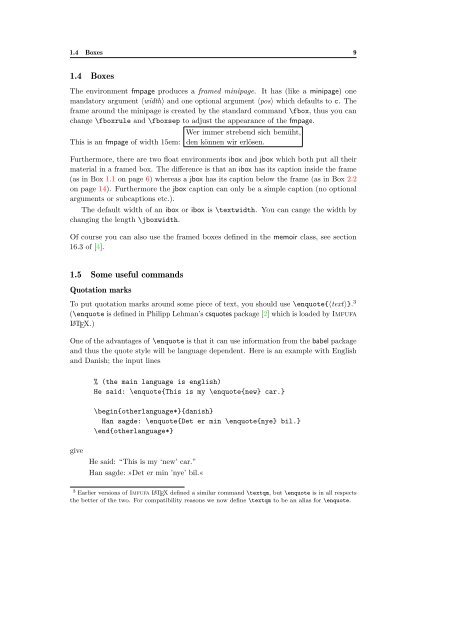You also want an ePaper? Increase the reach of your titles
YUMPU automatically turns print PDFs into web optimized ePapers that Google loves.
1.4 Boxes 9<br />
1.4 Boxes<br />
The environment fmpage produces a framed minipage. It has (like a minipage) one<br />
manda<strong>to</strong>ry argument 〈width〉 and one optional argument 〈pos〉 which defaults <strong>to</strong> c. The<br />
frame around the minipage is created by the standard command \fbox, thus you can<br />
change \fboxrule and \fboxsep <strong>to</strong> adjust the appearance of the fmpage.<br />
This is an fmpage of width 15em:<br />
Wer immer strebend sich bemüht,<br />
den können wir erlösen.<br />
Furthermore, there are two float environments ibox and jbox which both put all their<br />
material in a framed box. The difference is that an ibox has its caption inside the frame<br />
(as in Box 1.1 on page 6) whereas a jbox has its caption below the frame (as in Box 2.2<br />
on page 14). Furthermore the jbox caption can only be a simple caption (no optional<br />
arguments or subcaptions etc.).<br />
The default width of an ibox or ibox is \textwidth. You can cange the width by<br />
changing the length \jboxwidth.<br />
Of course you can also use the framed boxes defined in the memoir class, see section<br />
16.3 of [4].<br />
1.5 Some useful commands<br />
Quotation marks<br />
To put quotation marks around some piece of text, you should use \enquote{〈text〉}. 3<br />
(\enquote is defined in Philipp Lehman’s csquotes package [2] which is loaded by <strong>Imfufa</strong><br />
L A TEX.)<br />
One of the advantages of \enquote is that it can use information from the babel package<br />
and thus the quote style will be language dependent. Here is an example with English<br />
and Danish; the input lines<br />
% (the main language is english)<br />
He said: \enquote{This is my \enquote{new} car.}<br />
\begin{otherlanguage*}{danish}<br />
Han sagde: \enquote{Det er min \enquote{nye} bil.}<br />
\end{otherlanguage*}<br />
give<br />
He said: “This is my ‘new’ car.”<br />
Han sagde: »Det er min ’nye’ bil.«<br />
3 Earlier versions of <strong>Imfufa</strong> LATEX defined a similar command \textqm, but \enquote is in all respects<br />
the better of the two. For compatibility reasons we now define \textqm <strong>to</strong> be an alias for \enquote.
















